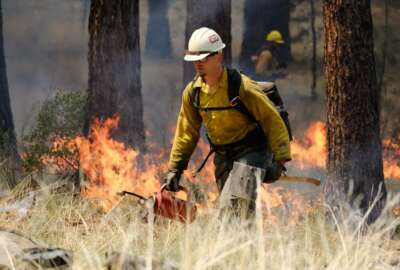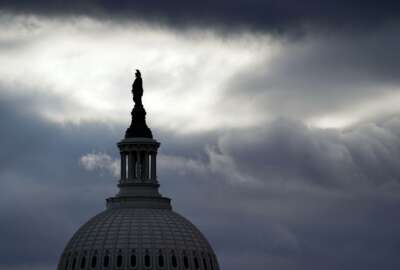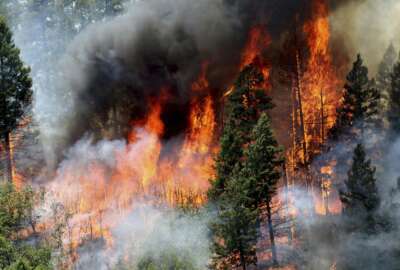Interior, USDA to implement pay raises for federal firefighters later this month
About 3,500 federal firefighters at the Interior Department and 11,300 others at the Agriculture Department's Forest Service will see pay raises to meet a $15 an...
Thousands of federal wildland firefighters are getting a pay raise next week.
The Agriculture and Interior Departments on Tuesday announced a joint effort to implement pay raises for federal firefighters making less than $15 an hour to reach that amount.
The pay raises apply to some 3,500 federal firefighters at the Interior Department and 11,300 at USDA’s Forest Service, the agencies said.
Raises will be retroactive to June 30, and federal firefighters should start to see salary bumps reflected in their paychecks starting around Aug. 24.
In addition, all temporary frontline firefighters will receive a $1,300 bonus, while all permanent frontline workers up to GS-9 will get an award equal to 10% of six months’ base pay, the departments said.
Salaries range for wildland firefighters depending on where they work and their rank on the General Schedule.
Entry-level wildland firefighters come into government as GS-2s, 3s or 4s, where pay ranges from $12.33-to-$19.63 an hour, according to 2021 salary data from the Office of Personnel Management.
“As climate change brings longer fire seasons and more extreme fire behavior, we must remain steadfast in our commitment to wildland fire preparedness and response,” Interior Secretary Deb Haaland said in a statement. “The brave women and men on the frontlines deserve fair pay for their work to protect our families, our communities and our lands from the increasing threat of fire. By improving pay, we will not only support our wildland firefighters in a challenging year but also improve our ability to hire and retain top talent.”
All told, 3,500 out of 5,000 wildland firefighters at Interior’s Bureau of Land Management, Bureau of Indian Affairs, National Park Service and Fish and Wildlife Service will receive pay raises and awards worth $7.6 million.
At USDA’s Forest Service, 11,300 out of 14,500 wildland firefighters will receive salary bumps and bonuses worth $24.3 million, the departments said.
“This is a significant first step to ensuring America’s firefighters are fairly compensated for the hard work and sacrifices they make in bravely serving their country,” said Randy Erwin, national president of the National Federation of Federal Employees, which represents many seasonal and permanent firefighters. “No federal firefighter deserves to be paid less than $15 an hour and we are glad that the federal government is correcting this injustice.”
Still, the union is pushing Congress to improve pay and working conditions for federal firefighters on a long-term basis, citing a decades-long need to seriously overhaul the wildland fire system.
The Biden administration said the new pay initiatives are part of a broader, ongoing effort to modernize the federal firefighter workforce.
The Senate-passed Bipartisan Infrastructure Investment and Jobs Act includes $600 million for federal wildland firefighter salaries and other workforce initiatives.
Specifically, agencies will use those funds to convert at least 1,000 seasonal workers to permanent members of the federal firefighter workforce.
The funds will also cover salary bumps for current wildland firefighters, but under specific circumstances. The infrastructure bill directs Interior, USDA and the Office of Personnel Management to create a new wildland firefighter occupation series.
Under the new job series, positions located in a specified geographic region where it’s difficult to recruit and retain federal firefighter talent will be eligible for an annual salary increase of $20,000 or an amount worth 50% of base pay, whichever is less.
Current federal firefighters can opt into the new classification system or stay within their current job series, according to the Senate bill. In addition, the proposal calls for the Interior and Agriculture secretaries to develop recommendations for minimizing environmental hazard exposures on the federal firefighter workforce, as well as addressing mental health and post-traumatic stress challenges on employees.
“We strive to provide an inclusive work environment where employees have access to all of the tools they need to be safe, as well as the training to make informed risk management decisions in the fire environment,” Halaand and USDA Secretary Tom Vilsack said in a May 13 memo outlining their goals to wildland firefighter management. “Employee wellbeing is important, and we seek to support the current and future health of our employees. Physical and mental safety are priorities in making the wildland fire community a place where all can contribute to the goals of effective wildland fire mitigation and response.”
Federal employee organizations like NFFE are hopeful the Senate infrastructure bill will pass the House and retain current language designed to give wildland firefighters a more permanent pay solution.
In the meantime, both USDA and Interior are trying to convert more seasonal and temporary federal firefighters to become permanent employees.
The Forest Service has converted 500 temporary positions to permanent jobs in the last two years, USDA said.
In fiscal 2022, both agencies plan to create 235 new permanent positions.
Copyright © 2025 Federal News Network. All rights reserved. This website is not intended for users located within the European Economic Area.
Nicole Ogrysko is a reporter for Federal News Network focusing on the federal workforce and federal pay and benefits.
Follow @nogryskoWFED






